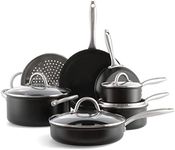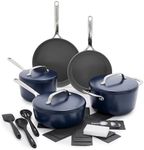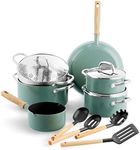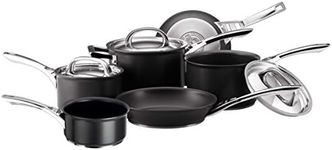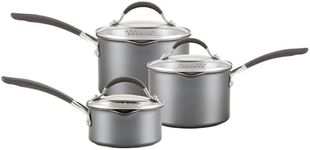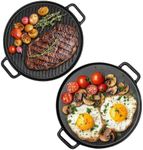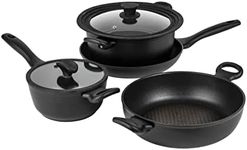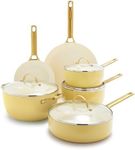Buying Guide for the Best Nonstick Cookware Sets
Choosing the right nonstick cookware set can greatly enhance your cooking experience, making it easier to prepare meals and clean up afterward. Nonstick cookware is designed to prevent food from sticking to the surface, which can be particularly useful for cooking delicate items like eggs or pancakes. When selecting a nonstick cookware set, consider the types of dishes you frequently prepare, your cooking habits, and the maintenance you're willing to commit to. Understanding the key specifications will help you make an informed decision that suits your culinary needs.MaterialThe material of nonstick cookware affects its heat conductivity, durability, and weight. Common materials include aluminum, stainless steel, and hard-anodized aluminum. Aluminum is lightweight and heats up quickly, making it ideal for everyday cooking. Stainless steel is more durable and resistant to scratches but may not heat as evenly. Hard-anodized aluminum offers a balance of durability and heat distribution. Choose a material based on your cooking style: if you need quick heating, go for aluminum; for durability, consider stainless steel or hard-anodized options.
Nonstick CoatingThe nonstick coating is what prevents food from sticking to the cookware. Popular coatings include Teflon and ceramic. Teflon is known for its excellent nonstick properties but can degrade at high temperatures. Ceramic coatings are free from PTFE and PFOA, making them a healthier option, but they may not be as durable. If you often cook at high temperatures, consider ceramic coatings. For general use, Teflon can be a good choice, but ensure you use it at recommended temperatures to maintain its longevity.
Number of PiecesCookware sets come with varying numbers of pieces, typically ranging from 5 to 15 or more. A basic set might include a frying pan, saucepan, and a pot, while larger sets offer more variety, including lids and specialty pans. Consider the size of your household and the types of meals you prepare. A smaller set may suffice for simple meals or a single person, while a larger set is beneficial for families or those who enjoy cooking a variety of dishes.
Oven SafetyOven safety refers to the maximum temperature the cookware can withstand in an oven. This is important if you plan to use your cookware for recipes that require finishing in the oven. Most nonstick cookware can handle temperatures up to 350°F to 500°F. If you frequently bake or roast, ensure your cookware is oven-safe to the temperatures you typically use. Check the manufacturer's guidelines to avoid damaging the nonstick coating.
Handle DesignThe design of the handles affects comfort and safety during cooking. Handles can be made from stainless steel, silicone, or plastic. Stainless steel handles are durable and oven-safe but can get hot. Silicone and plastic handles stay cool to the touch but may not be oven-safe. Consider how you cook: if you often move pans from stovetop to oven, opt for stainless steel. For stovetop use only, silicone or plastic handles offer comfort and safety.
Compatibility with CooktopsNot all cookware is compatible with every type of cooktop. Some nonstick cookware is designed for use on gas, electric, or induction cooktops. Induction cooktops require magnetic materials, so ensure your cookware is compatible if you have one. Check the product specifications to ensure compatibility with your cooktop type. If you have multiple cooktops or plan to change in the future, look for versatile cookware that works on all surfaces.

